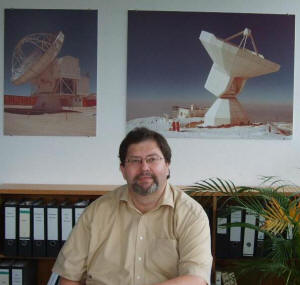2007 Jansky Lecturer: Professor Karl M. Menten
 Associated Universities, Inc. and the National Radio Astronomy Observatory are pleased to announce that the 42nd annual Karl G. Jansky Lecture will be given by Professor Karl M. Menten of the Max-Planck-Institut für Radioastronomie in Bonn, Germany.
Associated Universities, Inc. and the National Radio Astronomy Observatory are pleased to announce that the 42nd annual Karl G. Jansky Lecture will be given by Professor Karl M. Menten of the Max-Planck-Institut für Radioastronomie in Bonn, Germany.
Professor Menten studied physics and astronomy at the University of Bonn, Germany, completing his dissertation on"Interstellar Methanol towards Galactic HII Regions" and his doctoral degree in 1987. He then joined the Harvard-Smithsonian Center (CfA) for Astrophysics in Cambridge, Massachusetts, where he was a Postdoctoral Fellow and a Research Associate for several years. From 1992 through 1996, Professor Menten continued to conduct research as a Radio Astronomer, then Senior Radio Astronomer, at the CfA. He then became the Director for Millimeter and Submillimeter Astronomy at the Max-Planck-Institut für Radioastronomie in Bonn in 1996, a position he still holds. Since 2001, he has also been a Professor for Experimental Astrophysics at the University of Bonn.
Professor Menten is an extraordinarily productive scientist whose research has improved our fundamental understanding of molecular clouds, astrochemistry, star formation in the Milky Way and in the early Universe, and circumstellar envelopes around stars in the late stages of their evolution. In particular, he has used cosmic masers as observational probes for many astronomical environments. Professor Menten is particularly interested in the dense, hot regions around forming and recently formed high-mass stars. Since the stupendous energy production of these stars, which are much heavier than our Sun, profoundly influences interstellar matter on a galactic scale, it is important to investigate their origins.
Using the NRAO 140 Foot Telescope at Green Bank in 1991, he discovered very strong methanol maser emission in galactic star-forming regions, a discovery that developed into a powerful tool for studying massive star formation. (A maser is the radio- wavelength equivalent of the shorter-wavelength laser). In interstellar clouds maser radiation is produced by natural action from newly formed stars and intense maser beams guide astronomers to stellar birthplaces. Because maser emission is very bright and arises from compact regions it can be observed with ultra-high resolution by combining telescopes thousands of miles apart. Professor Menten pioneered the first such Very Long Baseline Interferometry of methanol masers soon after their discovery and currently is co-leading a large-scale project that uses the NRAO Very Long Baseline Array for high precision maser observations to probe the structure, size, and dynamics of the Milky Way.
Professor Menten has observed emission from interstellar molecules at wavelengths as long as many centimeters. However, the variety of molecular emission is much greater at shorter wavelengths of a millimeter or less. To create a platform for research in submillimeter astronomy, Professor Menten initiated the Atacama Pathfinder Experiment (APEX), a 12-meter diameter telescope on the high elevation Chajnantor site in Chile's Atacama Desert, where the Atacama Large Millimeter/submillimeter Array (ALMA) is now under construction. True to its name, APEX has pioneered submillimeter science on the Atacama plateau and proved the quality of the site for astronomical research at millimeter and submillimeter wavelengths.
The dates and locations for Professor Menten's 2007 Jansky Lectures, titled "Tuning in to the Molecular Universe", are as follows:
- Macey Center, Socorro, NM, on October 19 at 8 p.m.
- NRAO Visitors Center, Green Bank, WV, on October 22 at 7 p.m.
- UVA Gilmer Hall, Room 130, Charlottesville, VA, on October 24 at 7 p.m.
Fred K.Y. Lo
NRAO Director




Connect with NRAO